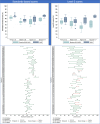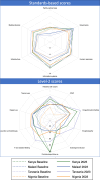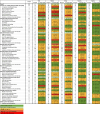Small and sick newborn care: Changes in service readiness scoring between baseline and 2023 for 65 neonatal units implementing with NEST360 in Kenya, Malawi, Nigeria, and Tanzania
- PMID: 40561081
- PMCID: PMC12193846
- DOI: 10.1371/journal.pgph.0004367
Small and sick newborn care: Changes in service readiness scoring between baseline and 2023 for 65 neonatal units implementing with NEST360 in Kenya, Malawi, Nigeria, and Tanzania
Abstract
Health Facility Assessments (HFAs) are important for measuring and tracking service readiness for small and sick newborn care (SSNC). NEST360 Alliance aims to reduce neonatal mortality in four countries (Kenya, Malawi, Nigeria, Tanzania). NEST360 and UNICEF facilitated HFA tool design with ministries of health in four African countries and developed two complimentary approaches to summarise readiness. Using the NEST360/UNICEF HFA tool, we collected data, developed two service readiness scoring approaches for SSNC (standards-based scoring by adapted World Health Organization (WHO) health system building blocks (HSBBs) and assessing service readiness across the health system, and level-2+ scoring by WHO clinical interventions), and applied across 65 neonatal units implementing NEST360. Service readiness change was assessed between baseline (Sept 2019-March 2021) and follow-up HFA (May-July 2023). For each neonatal unit, a percentage difference score was computed between baseline and 2023 HFA scores. Scores were calculated for each neonatal unit as the unit of analysis, and disaggregated by HSBB, clinical intervention, and sub-modules. Data from 65 neonatal units were analysed, i.e., 36 in Malawi, 13 in Kenya, 7 in Tanzania, and 9 in Nigeria. Median time between baseline and 2023 HFAs was 31 months [IQR 29-34 months]. Median baseline and 2023 scores were 41% [IQR 35-52%] and 55% [IQR 46-62%] respectively with 14% median score change [IQR 4-18%] for level-2+ scores. For standards-based scores, median baseline and 2023 scores were 51% [IQR 48-58%] and 60% [IQR 54-66%] respectively with a 9% median score change [IQR 3-11%]. Hospitals in Tanzania [Median 24%, IQR 16-30%] and Nigeria [Median 28%, IQR 17-30%] showed greater improvements on average for level-2+ scores compared to hospitals in Kenya and Tanzania. Data on changes in service readiness scores can be used to track service readiness over time, benchmark between hospitals, identify gaps, and assess progress towards newborn targets.
Copyright: © 2025 Penzias et al. This is an open access article distributed under the terms of the Creative Commons Attribution License, which permits unrestricted use, distribution, and reproduction in any medium, provided the original author and source are credited.
Conflict of interest statement
The authors have declared that no competing interests exist.
Figures




References
-
- World Health Organization. Six years to the SDG deadline: Six actions to reduce unacceptably high maternal, newborn and child deaths and stillbirths. In: Every Woman Every Newborn Everywhere. Geneva: Every Woman Every Newborn Everywhere; 2024. https://cdn.who.int/media/docs/default-source/mca-documents/wha/2-pager-...
-
- World Health Organization. Survive and Thrive: Transforming care for every small and sick newborn. World Health Organization; 2019. 150. https://iris.who.int/bitstream/handle/10665/326495/9789241515887-eng.pdf...
-
- Brun MMJ, Moreira I, Agbigbi Y, Lysias J, Schaaf M, Ray N. Implementation Manual for Developing a National Network of Maternity Units - Improving Emergency Obstetric and Newborn Care (EmONC). United Nations Population Fund (UNFPA); 2020. https://www.unfpa.org/featured-publication/implementation-manual-develop...
-
- Demographic and Health Surveys. Service Provision Assessment (SPA) Overview. 2022. [cited 31 July 2024]. In: Demographic and Health Surveys. https://dhsprogram.com/Methodology/Survey-Types/SPA.cfm
-
- World Health Organization. Service availability and readiness assessment (SARA): reference manual, version 2.2. Geneva: World Health Organization; 2015. https://www.who.int/publications/i/item/WHO-HIS-HSI-2014.5-Rev.1
LinkOut - more resources
Full Text Sources
